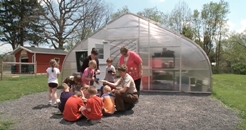 School and community needs as real-world catalysts for learning
School and community needs as real-world catalysts for learning
From an article by Edutopia
By using real-world problems as projects for children to solve, a primary school in the USA empowers, engages, and excites students about what they can learn and how they can use that knowledge.
Teacher Karen Gilpin says, "By showing them that what we're doing in the classroom is affecting their community and helping their community, they see its value, and so they're willing to buy-in, even if the academics get a little hard, they're willing to work a little harder."
When designing projects and lessons at Crellin Elementary in Maryland, teachers regularly look at school and community needs with the idea of using those needs as real-world catalysts for learning, instead of inventing problems for the kids to solve. Learning is made more tangible and real this way, and students are also empowered by discovering that they are able to enact change in the world around them. They become more engaged and passionate about learning because they can see the direct results.
A core value in the school is community service. Teachers and staff are always seeking ways for the school to give back to the community, whether by planting a community garden or helping cook meals for a local community centre. But rather than just service for service’s sake, the school finds local problems that they can solve and ties these projects to learning objectives. By doing so, they make learning relevant and engaging. This approach helps kids immediately see the reasons for what they're learning and need to apply knowledge e.g. maths to calculate sizes, etc.
Crellin teachers suggest three main ways of finding real-world problems for students to solve:
1. Keep Your Eyes Open for Problems
Crellin teachers are always looking for real-world problems -- either in the school or the surrounding community -- from which students can learn. They find interesting opportunities by reading newspapers or talking with members of the community. Building relationships with community members can really help.
2. Tie Projects to Learning Objectives
Once a problem has been identified, teachers begin looking for ways to use that problem or issue as a catalyst for learning: What standards can they tie in? How can they broaden the issue to hit more learning objectives? For example, cooking, where students use math, reading, following directions, and working with measurement tools. They make sure projects hit learning objectives and are not just random problems that will only confuse their students.
3. Let Students Help Steer
When you have multiple real-world problems or issues to choose from, turn to students for input on what they find the most interesting as well as beneficial. Such student choice can be part of the learning. This way, not only do students feel a sense of ownership, but the teachers also know in advance that there's some interest in the issue.
What are the benefits?
Once students are able to be actively involved in solving problems that have tangible outcomes, they become more invested in solving other problems. This takes them deeper into the learning that they need for finding those solutions.
This way the kids are taught to be critical thinkers, to be reflective, to be creative. They'll have the skills they need to think something through logically.
It's an opportunity to make something good happen. That gives the kids a sense of belonging and a sense of being a part of something bigger.
Watch a 5 minute video about the approach:
More details are here.
What issues in the community can the children you work with help solve? How might this change Youthwork?
Retweet about this article:
From an article by Edutopia, 25/10/2017